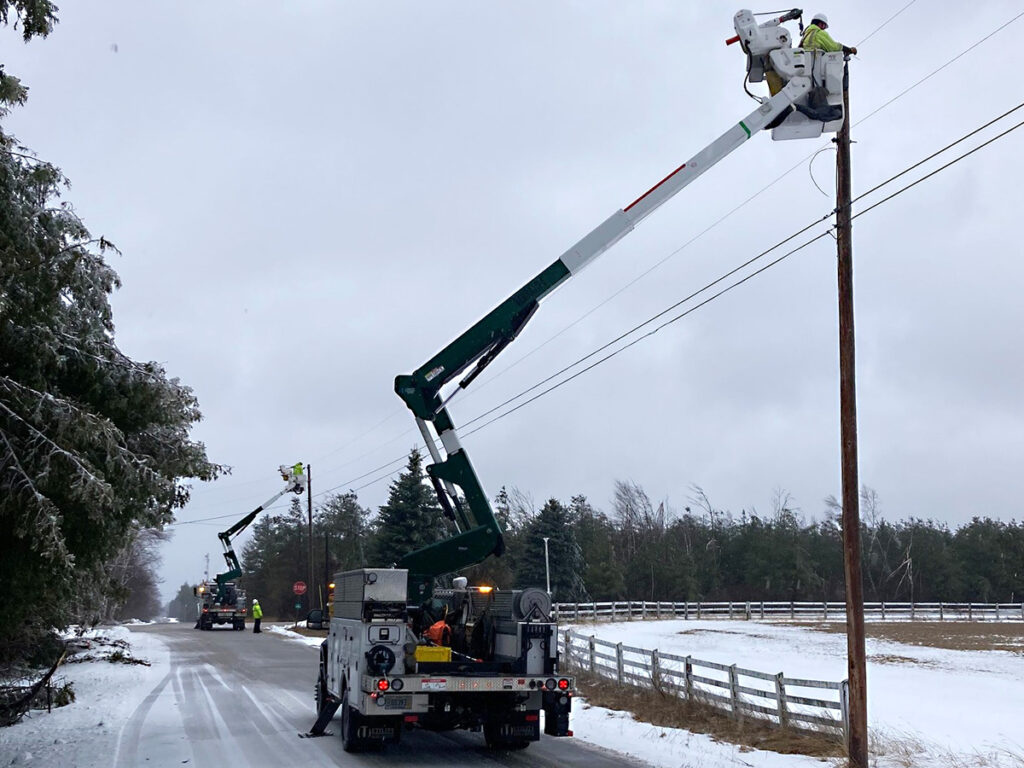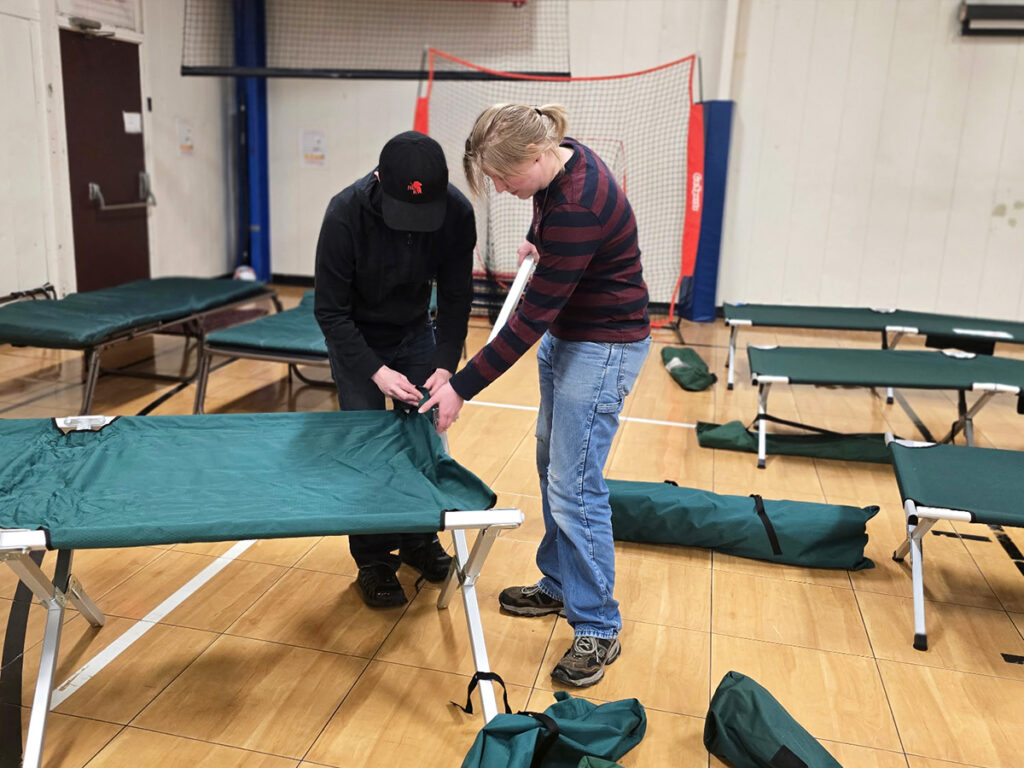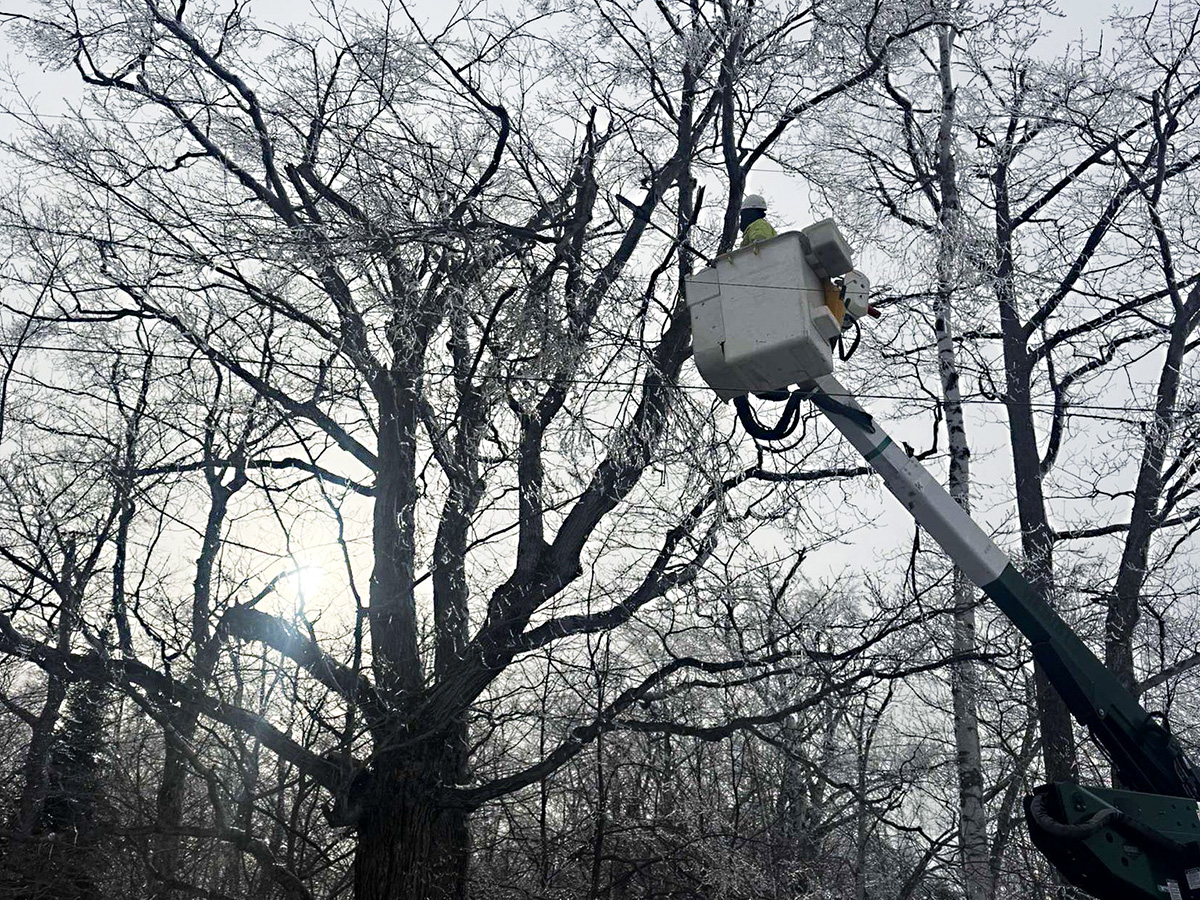The northern part of the Door County peninsula, especially Washington Island, experienced power outages when a winter storm blew through northeastern Wisconsin on March 28 and 29. Ice accumulation accompanied by high winds caused extensive damage to trees and grid infrastructure. Nearly the entire island did not have electricity or running water for several days, and parts of Sister Bay and the peninsula were out for at least 30 hours.
(Fox News 11 meteorologists and other outlets like The Weather Channel have adopted the practice of naming high impact winter storms. The National Weather Service does not name winter storms, only tropical storms.)
Representatives from the Wisconsin State Climatology Office and local emergency management teams said Door County residents and communities should have plans in place for more extreme winter storms in the future.
What to do for a weather emergency, before the lights go out
When the only certainty is uncertainty, individuals and communities can take measures to prepare themselves for future emergencies and extreme weather events. Read more
The Town of Washington currently has no comprehensive municipal emergency plan in place, according to town representatives. However, the community responded “like a well-oiled machine” during Frannie, according to Door County Emergency Management Director Jeb Saelens.
Lessons learned from Winter Storm Cora, which took place last year at almost exactly the same time, were part of the reason for such a robust community response to Frannie, Adam Steffen said. Steffen is assistant chief for the Washington Island Fire Department.
“It was deja vu,” he said, referring to last April when Cora knocked out power for the whole island and much of Door County during spring elections. Last year was the first time the Red Cross was dispatched to the Island to establish an emergency shelter. This year was the second time.
Specific, and frustrating, conditions
While Cora brought wet heavy snow that weighed down trees, power lines and poles, Frannie brought ice that was an inch thick in some places. It coated every branch, twig and exposed surface, making everything north of Baileys Harbor a glittering wonderland.
“It was the most beautiful disaster I’ve ever seen,” Saelens said.
Very specific conditions must exist for ice accumulation on this scale, according to Amanda Schwabe, climate outreach specialist from the Wisconsin State Climatology Office. The Earth’s atmosphere has layers, “like a cake,” Schwabe explained, and for Frannie’s ice accumulation to occur, precipitation starts as rain in the warmer upper layers, hits the freezing layer closer to the ground and immediately freezes.
A little warmer at the surface and it stays rain, a little colder in the upper layer and it falls as snow, she said.

Pouring rain and temperatures of 29 to 30 degrees Fahrenheit on Friday led to most island residents losing power early Saturday evening. Parts of Sister Bay and further north lost power on Sunday when a tree fell on a main transmission line.
About 2,800 Wisconsin Public Service customers were without electricity for 30 hours on the peninsula, according to Saelens. Washington Island’s electricity is managed by the Washington Island Electric Cooperative, and not a single one of the grid’s 54 circuit breakers was unaffected, according to Manager Robert Cornell.
Cornell said it was the worst storm in terms of infrastructure repair that he has seen in 27 years on the job. He estimated the cost to the cooperative to be near $250,000, though he said he is “still putting the numbers together.”
The cooperative should be able to recoup some of those costs through state disaster relief funds, according to Saelens.
Cornell is one of two linemen for the cooperative, but he was the only one on the island when the storm hit. He said he spent most of Saturday repairing lines on his own, and when he and Mike Jorgenson, the other lineman, returned to working on Sunday, all of Cornell’s previous work had been undone.
The heavy ice and continuing high winds meant branches, trees and poles kept falling even after the worst of the storm was over, Cornell said. Cora’s heavy snow in April 2024 caused similar issues, but “you can thump snow off a whole line,” he said. “You can’t do that with ice.”
Backup utility crews arrived to help on Sunday afternoon, Cornell said, as a result of the Restoration of Power in an Emergency program, a mutual assistance program for electric cooperatives in Wisconsin to help each other restore power after emergencies.
Two crews from the Adams-Columbia Electric Cooperative arrived on the Island Sunday afternoon, and another came the next day, according to Cornell. Karcz Utility Services also sent reinforcements to help reset electrical poles. The extra workers, Washington Island public works employees and many volunteers “busted their tails” to get power restored to residents, he said.
A common question people ask is whether there is anything that can be done by utility companies or government agencies to make lines and poles less vulnerable to extreme weather, according to Cornell. One suggestion is to bury power lines underground, he added.
On a municipal and county level, burying power lines is an expensive option. According to Cornell, it has been done in some areas of the island already, but it is prohibitively expensive and in some areas impossible due to shallow bedrock.
A little less than two miles of buried line cost the cooperative almost $300,000, Cornell said. The island has 117 miles of line.
Emergency shelter
While linemen and volunteers were responding to damage Sunday morning, and residents were waking up to an ice-covered world, Steffen was contacting Kari Gordon, chairperson of the town’s community center committee.
Gordon stepped into the lead role at the designated emergency shelter in the Island Community Center. The shelter was open and operational by 10 a.m. on Sunday.
The shelter served three hot meals a day and provided water, dry goods, supplies, warmth, charging stations, overnight accommodations and community fellowship for 950 people — counting repeat users — by the time it closed on Wednesday evening, Gordon said.

“I was cold-calling people, asking them to help,” she said. Several volunteers were stuck in their driveways by downed trees, ice-coated roads and power lines. Fire department members provided rides for those that needed them, Gordon said.
Island restaurants and residents brought food and volunteers coordinated meals in the Community Center’s commercial kitchen, she said. A Red Cross trailer full of pallets of water and dry goods, most of it donated by Walmart in Sturgeon Bay, arrived Sunday afternoon. On Monday, the Salvation Army sent more food and another Red Cross supply arrived as well.
Communication issues and solutions
The first thing Gordon and volunteer Annie Rohrer did on Sunday was provide Steffen and department members with a list of potentially vulnerable residents to check on. The department performed 150 individual welfare checks on Sunday, Steffen said, a much different scenario than during Cora when responders went door-to-door.
The biggest factor between 150 welfare checks this year versus 700-plus last time was communication, he explained. Even though the island’s Cellcom tower and backup generator were down, meaning many people lost cell phone service, most phones were able to receive emergency alerts through Door County Ready and the Integrated Public Alert & Warning System.
Neither service was available last year during Cora, according to Saelens. Door County Ready is a voluntary program designed to keep residents and visitors informed during critical situations, and IPAWS is a text messaging program designed to message all cell phones in a geographical area, he said.

Two messages went out via the systems, letting people know the Community Center was an emergency shelter on the island. On the peninsula, the Aging and Disability Resource Center-Door County Community Center in Sturgeon Bay is a designated warming shelter, and a Red Cross trailer was stationed in Sister Bay, but Saelens said it was not needed this time.
The mainland began reconnecting to power by late Sunday, Saelens said, and several area hotels that maintained electricity offered discounted rates for those affected by outages.
The biggest challenge faced by island emergency responders during Frannie was that their own communications were not working, according to Steffen. The Door County Sheriff’s Office brought a mobile command center with a portable repeater tower by Sunday afternoon, Steffens said, but until then radio connection between island personnel was not working well.
To mitigate this problem, responders set up a command center at the Community Center, which proved to be convenient, as shelter volunteers were able to quickly get messages and information to responders in the same building.
The Door County Emergency Services building on the island, usually the command center in an emergency, was unavailable because of a faulty sensor at that building’s generator.
Local government needs a plan
While everything at the island’s shelter went smoothly, a comprehensive plan for emergencies is a priority, according to Gordon and town board representatives.
Saelens agreed and said getting every municipality to develop an emergency plan has been one of his goals since he became emergency management director.
“You develop it during a blue sky day so you’re not dealing with it during an incident,” Saelens said. He added that it is critical for communities to document everything during an emergency. Every volunteer hour, every service provided, every dollar spent, Saelens said, because when you go to present it a few months later to the state for emergency funding reimbursement, “if you didn’t document, it didn’t happen.”
According to Washington Island Town Supervisor Margaret Foss, an emergency plan for the town is of the highest priority.
“I want to reassure the community that this will happen,” she said.

Peter Sownie echoed Foss’ sentiment in a phone conversation April 3. He was elected town chairman on April 1 and will be taking over for current chairman Hans Lux on April 15. Sownie served as a town supervisor for a year before running for the chairman’s seat.
There is a draft of an emergency plan but it is not complete, according to Sownie, and he said he will put together a task force to take the draft and work with involved parties to create a thorough town emergency plan.
“Hopefully this is not an annual event, but we need to have something to refer to,” he said.
April 1 was an election day, but Frannie did not hit right on election day as Cora did last year. Voter turnout on the island and across the peninsula was higher than in 2024’s or 2023’s spring elections.
For Washington Island, elections are normally held at the Community Center, and it was no different this year. By Tuesday, emergency responders had regained their communications and were able to vacate the room they had been using to open as a polling place.
Changing climate, both physical and social
“This is really new ground,” Washington Island Fire Department Chief Peter Nehlsen said, referring to the responsibilities of rural fire departments, Door County demographics and societal shifts.
Nehlsen has been on the island’s fire department for 40 years, he said and it does not run the way it did even 20 years ago. “Now the primary function of the fire department is as emergency problem solvers, versus only fighting fires,” he said.
Additionally the population is larger, and there are more elderly people than ever before.
“There are about 500 houses out there with people who could be in trouble,” Nehlsen said, indicating aging and medically frail residents.
According to U.S. Census Bureau data, the Door County population has gone from 20,106 in 1970, to an estimated 30,584 in 2025. Additionally, the median age of Door County is about 53, compared to about 39 for the state of Wisconsin. The Door County median age has increased over the past 40 years, with its share of older residents growing larger. The number of residents 65 years and older has increased from 23 percent in 2010 to 30 percent in 2020, and is expected to keep growing.
Besides more people overall and a growing elderly population, Nehlsen said social change makes emergencies more complex. Even a few decades ago, according to Nehlsen, most island residents were able to be more independent and “off the grid” for a few days than they can now. More people also had woodstoves and fireplaces heating their homes, he said.
Reliance on technology goes beyond physical needs too. “We are more dependent on power, the normalcy of being connected,” Nehlsen said. “So when the connection is cut off, people don’t know what to do.”

Knowing what to do when the power goes out should be something everyone is familiar with, particularly in rural areas, because storms like Cora and Frannie are likely to be more frequent and less predictable in the future, according to Schwabe at the Wisconsin State Climatology Office.
Climate change and the warming of the Arctic contribute to intensity and frequency of winter storms, she said. Huge winter storms do not typically develop when it is very cold because the air is dry, Schwabe said, and Wisconsin winters are about 3-6 degrees warmer on average than they were in 1950. Warmer air in the atmosphere holds more moisture, so the same winter storm that may have fizzled out in colder temperatures will get more intense as it moves into a humid atmosphere that supports it, she explained.
On the flip side, warming in the Arctic can also lead to blasts of subzero air in temperate areas like northeastern Wisconsin, Schwabe said.
“The polar vortex is always there. It’s like a lasso that keeps cold air in the Arctic, and when it’s really strong it is a perfect circle,” she said. Melting sea ice creates warmer air which weakens the lasso and releases more cold air to southern regions, she said.
Then, “If we get an outbreak of cold, it freezes the ground, followed by a warm week with a system of rain?” Schwabe said. “That could lead to freezing rain and ice storms like the ones we have seen recently.”
Ice storms are already unpredictable because they hinge on just a few degrees of temperature difference and are very localized, she said. Potentially, they may be even harder to predict due to recent federal funding and employee cuts at the National Oceanic and Atmospheric Administration and National Weather Service, she added.
Predictions regarding ice storms rely on atmospheric temperature data. As of late March, the National Weather Service in Green Bay is releasing one, instead of two, weather balloons each day, Schwabe said. “They record layers of the atmosphere with real time data to look at and put in forecast models. Not getting real data as frequently means really fine-tuned forecasts may be harder.”
A representative from the Green Bay National Weather Service office confirmed it is down to one weather balloon a day and the decision “was handed down from above.”
The National Weather Service Public Affairs office did not provide an answer as to whether the number of weather balloons released in Green Bay impacted the predictability of Frannie in particular. The office referred to a public information statement it issued on March 20 instead. The statement cited lack of staffing as the reason for the decision to go from two balloons to one.
Adding to the complexity of predicting winter storms is that areas close to the Great Lakes are more susceptible because they are seeing big changes in ice coverage and that also affects moisture content in the air and regional temperatures, Schwabe explained.
The various factors that play into northeastern Wisconsin winter weather—temperatures rising, more warm, moist air, the instability of the polar vortex—could lead to “a whole range of possibilities. It’s hard to say, but we know things are changing and continue to change.”
Correction: A previous version of this story incorrectly stated Adam Steffen’s position. His position is assistant chief, not captain. The story has been corrected.

